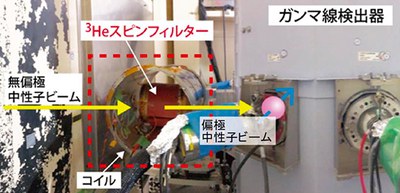
Exploring the origin of elements and universe through neutron-nucleus reactions
A group of researchers from Nagoya University, the Japan Proton Accelerator Research Complex (J-PAEC) of the Japan Atomic Energy Agency, and Research Center for Nuclear Physics (RCNP) of Osaka University has measured γ-rays emitted from the neuron-induced compound state of 140La and discovered transverse asymmetry (sidedness) of these γ-rays.
Matter (a matter particle) and antimatter (an antimatter particle) are produced as a pair and every type of particle is associated with an antiparticle with the same mass but with opposite physical charges. It is believed that matter and antimatter were originally created in equal amounts during the Big Bang; however, the universe today is almost entirely filled with matter. This means that all antimatter was gone.
If CP* symmetry, which states that the laws of physics are the same if particles were interchanged with their antiparticles, is correct, the dominance of matter over antimatter in the present universe cannot be explained. CP-symmetry must be violated and there is difference, or “asymmetry,” which is known as CP violation.
*CP means charge conjugation (C), and parity (P) and charge conjugation implies that every charged particle has an oppositely charged antimatter counterpart, or antiparticle.
A nuclear reaction in which a neutron is absorbed by a nucleus and forms a compound is called a neutron capture reaction and emits γ-rays. In neutron-induced nuclear reactions, there is a phenomenon in which a reaction cross section at certain energies increases by many orders of magnitude in a phenomenon called resonance.
The parity violation occurs in a p-wave resonance (neutron orbital angular momentum l = 1) located at the tail of an s-wave resonance (l = 0). In p-resonance, the violation of the parity symmetry (P-violation) is amplified up to about 106 times compared to nucleon-nucleon scatterings. It is understood that fundamental P violation in the neutron absorption reaction is enhanced by the interference between s- and p-wave amplitudes, which is referred to as s-p mixing model.
After the formation of the highly excited state by an incident neutron, the compound nucleus can decay by emission of gamma radiation. Conservation of energy and angular momentum play a role in which emission takes place. The gamma ray angular distribution depends on the spin alignment.
The degree of P-violation enhancement can be calculated by investigating the cross section in the resonance region and the angular distribution of emitted γ-rays in the neutron capture reaction, a nuclear reaction that involves compound nucleus formation, using the polarized neutron beam.
This group focused on the nucleus of Lanthanum-139 isotope (139La), which exhibits large parity violation (P violation) in the neutron absorption reaction in the 0.74 eV p-wave resonance. In order to study the enhancement mechanism, the researchers injected unpolarized neutrons, polarized them by passing through the 3He spin, irradiated them to the nuclear target 139La at 0.74 eV, and measured the angular distribution of γ -rays in the neutron capture reaction by germanium detectors at J-PARC MLF BL04 ANNRI.
J-PARC: Japan Proton Accelerator Research Complex
MLF: Materials and Life Science Experimental Facility
BL04: Beamline 04
ANNRI: Accurate Neutron-Nucleus Reaction Measurement Instrument
The microscopic cross section (measured in barns) is the probability of a reaction between a neutron and an individual particle or nucleus and cross sections vary with neutron energy. In this study, the γ-ray yield in the vicinity of the p-wave resonance varied for the up- and down-polarization directions of incident neutrons.
The results of this study will lead to the clarification of enhancement of CP violation and the mysteries of the origin of the universe.
Figure 1
Figure 2
Figure 3
Figure 4
The article, “Transverse asymmetry of γ rays from neutron-induced compound states of 140La” was published in Physical Review at DOI: https://journals.aps.org/prc/abstract/10.1103/PhysRevC.101.064624.
